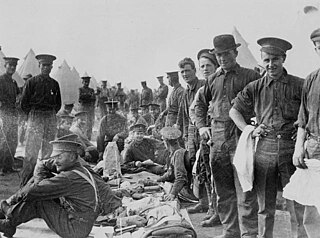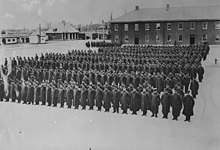
The 58th Battalion, CEF was an infantry battalion of the Canadian Expeditionary Force during the First World War.

The 29th Battalion (Vancouver), CEF was an infantry battalion of the Canadian Expeditionary Force during the Great War.

The 78th Battalion, CEF was an infantry battalion of the Canadian Expeditionary Force during World War I. The 78th Battalion was authorized on 10 July 1915 and embarked for Great Britain on 20 May 1916. It disembarked in France on 13 August 1916, where it fought as part of the 12th Brigade, 4th Canadian Division in France and Flanders until the armistice. The battalion was disbanded on 15 September 1920.

The 5th Battalion, CEF, known as "Tuxford's Dandys," was an infantry battalion of the Canadian Expeditionary Force during the Great War.

The 11th Battalion, CEF, an infantry battalion of the Canadian Expeditionary Force, was authorized on 10 August 1914 and embarked for Great Britain on 30 September 1914. It was redesignated as the 11th Reserve Infantry Battalion, CEF, on 29 April 1915, to provide reinforcements to the Canadian Corps in the field. On 4 January 1917, its personnel, along with the personnel of the 100th Battalion, CEF, were absorbed by a new 11th Reserve Battalion (Manitoba), CEF. The battalion was disbanded on 12 October 1917.

The 102nd Battalion, CEF, (initially the 102nd Battalion (Northern British Columbia), then after August, 1917, the 102nd Battalion (Central Ontario), CEF) was an infantry battalion of the Great War Canadian Expeditionary Force.
The 18th Battalion, CEF, was an infantry battalion of the Canadian Expeditionary Force in the Great War.

The 4th Battalion, Canadian Mounted Rifles was authorized on 7 November 1914 as the 4th Regiment, Canadian Mounted Rifles, CEF and embarked for Britain on 18 July 1915. It disembarked in France on 24 October 1915, where it fought as part of the 2nd Brigade Canadian Mounted Rifles until 31 December 1915, when it was converted to infantry and allocated to the 8th Canadian Infantry Brigade, 3rd Canadian Division. The regiment was redesignated the 4th Battalion, Canadian Mounted Rifles, CEF on 1 January 1916 and was disbanded on 6 November 1920.

The 116th Battalion, CEF, was an infantry battalion of the Canadian Expeditionary Force in the Great War.

The 21st Battalion, CEF was an infantry battalion of the Canadian Expeditionary Force in the Great War.

The 24th Battalion, CEF, was an infantry battalion of the Canadian Expeditionary Force during World War I.

The 26th Battalion CEF, was an infantry battalion of the Canadian Expeditionary Force during World War I. The 26th Battalion recruited throughout New Brunswick and was mobilized at Saint John, New Brunswick. The 26th Battalion, CEF, is perpetuated by The Royal New Brunswick Regiment.

The 8th Battalion, CEF, also known by the nickname of The Little Black Devils of Canada, was an infantry battalion of the Canadian Expeditionary Force during the Great War. The battalion was authorized on 10 August 1914 and embarked for Great Britain on 1 October 1914. It disembarked in France on 13 February 1915, where it fought as part of the 2nd Canadian Brigade, 1st Canadian Division in France and Flanders until the end of the war. The battalion was disbanded on 15 September 1920.

The 42nd Battalion, CEF, was an infantry battalion of the Canadian Expeditionary Force during the Great War.

The 44th Battalion (Manitoba), CEF, was an infantry battalion of the Canadian Expeditionary Force during World War I.

The 47th Battalion, CEF, was an infantry battalion of the Canadian Expeditionary Force during the Great War.

The 52nd Battalion, CEF, was an infantry battalion of the Canadian Expeditionary Force during the Great War.

The 54th Battalion (Kootenay), CEF, was an infantry battalion of the Canadian Expeditionary Force during the Great War.

The 72nd Battalion, CEF was an infantry battalion of the Canadian Expeditionary Force during World War I, and recruited throughout the province of British Columbia.
The 15th Battalion, CEF was an infantry battalion of the Canadian Expeditionary Force during the Great War. The 15th Battalion was authorized on 1 September 1914, embarked for Britain on 26 September 1914 and arrived in France on 15 February 1915. The battalion fought as part of the 3rd Canadian Brigade, 1st Canadian Division in France and Flanders throughout the war. The battalion was disbanded on 30 August 1920.






















